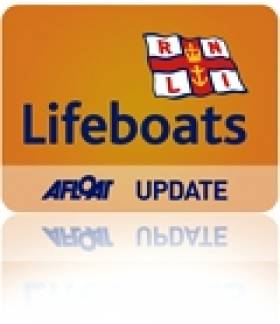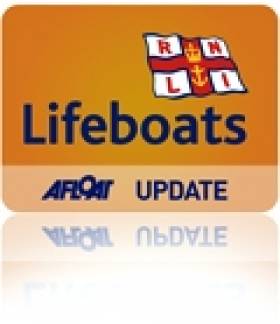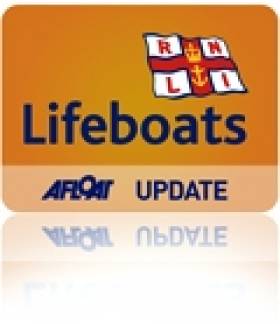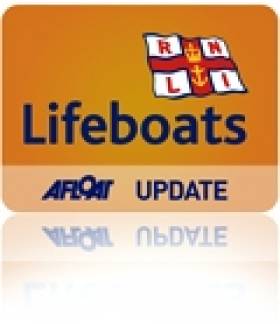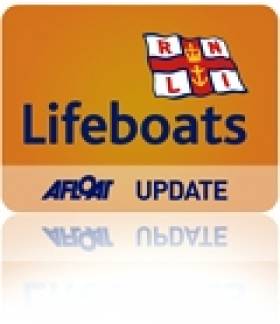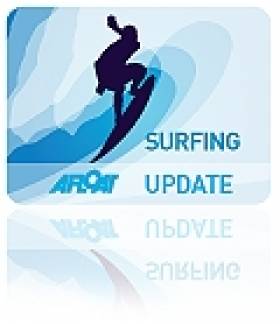Displaying items by tag: Bundoran
Station To Station Challenge Raises More Than €2,000 For RNLI
#RNLI - Two men who embarked on the first RNLI Station to Station challenge between Bundoran and Arranmore last Saturday (6 April) completed the job in just under 12 hours - raising over €2,000 for both lifeboat stations in the process.
As per their plan reported previously on Afloat.ie, Niall Clancy and James McIntyre both set off from Bundoran Lifeboat Station just after 6am on Saturday morning – Clancy running and McIntyre cycling.
Clancy's route took him through Bundoran, Ballyshannon, Donegal town, Mountcharles, Frosses, Glenties, Gweebarra Bridge, Lettermacaward, Dungloe, Burtonport and finally Arranmore Island via a treadmill on the ferry!
He was joined on various legs of the journey by members of the Tir Chonaill Athletic Club who kept his spirits up on the 100km journey from station to station.
Meanwhile, McIntyre and his team from Mullaghmore Triathlon Club and Donegal Bay Cycling Club took off at the same time cycling as far as Lough Eske, where James then made the lonesome journey himself across the Bluestack Mountains, constantly keeping organisers informed of his progress via text message.
Down into Glenties and from there by bike to Portnoo where, with Bundoran RNLI crewman Killian O’Kelly, he kayaked the remaining 22km to Arranmore Island, where both he and Clancy were greeted by the lifeboat crew and the Arranmore Pipe Band.
Speaking on completion of the challenge at Arranmore RNLI Lifeboat Station, Clancy said: "It’s been a long but great day. The weather conditions couldn’t have been any better for both myself and James – though it was very cold this morning leaving Bundoran!
"I’m looking forward to a few weeks off training before I get back into it for the Athlone Half Ironman in August."
McIntyre added: "We’d both like to express our gratitude to everyone who supported us ahead of the challenge and today – particularly those who sponsored us and those who ran and cycled with us today, our support teams, our chefs, the RNLI crews and sponsors Ormston’s Mace Ballyshannon and All Sports Donegal Town."
Shane Smith, volunteer lifeboat press officer for Bundoran RNLI, said: "We are thrilled at the success of the challenge and delighted that over €2,000 has been raised for both stations.
"We are indebted to James and Niall for their selfless support of our charity and would like to thank them sincerely on behalf of both crews."
Elsewhere, a Wexford family who organised a sponsored swim in memory of a loved one and former volunteer have raised a whopping €5,000 for Kilmore Quay RNLI.
The Hayes family presented the cheque to the RNLI at Kilmore Quay lifeboat station recently, funded by a sponsored swim on St Stephen’s Day organised by the family in memory of the late Paddy Hayes, who was a volunteer with the lifeboat.
Bundoran RNLI Lifeboat Called to Mullaghmore Incident
#rnli – The Bundoran RNLI lifeboat was tasked to an incident this morning, Monday March 18th 2013, in Mullaghmore, County Sligo.
A man in his 50s is understood to have been washed off rocks as he fished with friends off Mullaghmore Head. Due to the location of the man and his proximity to the water, the Bundoran RNLI Lifeboat was tasked by Malin Head Coast Guard and the crew launched.
They arrived on the scene 15 minutes later where Gardai and ambulance service were already assisting the casualty. The lifeboat crew were later stood down. The man was removed from the scene and brought to Sligo General Hospital where he was pronounced dead.
Challengers Gear Up For RNLI Station to Station
#RNLI - Two men are in training to complete the first RNLI Station to Station challenge on Saturday 6 April travelling from Bundoran Lifeboat Station to Arranmore Island Lifeboat Station in 10 hours – by foot, bicycle and kayak.
Leaving Bundoran lifeboat station at 6am on Saturday 6 April, Niall Clancy and James McIntyre will take two different routes and two different means to complete their challenge.
Clancy is set to run the entire distance of 100km door to door, including using a treadmill on the final leg from Burtonport Ferry Port via ferry to Arranmore Island, while McIntyre will cycle to Barnesmore Gap, run across the Blue Stacks down to Glenties, cycle to Portnoo and then kayak the remainder of the journey to Arranmore Island.
Clancy, a HSE advance paramedic, has already completed three marathons including Belfast and Dublin and also a half Ironman triathlon in Galway. He decided to do the challenge following a conversation with the Arranmore lifeboat crew during a recent visit.
He said: "The RNLI is a fantastic charity and as it is voluntary I wanted to do my bit to help raise funds for both Bundoran and Arranmore so, with James, we’re aiming to do that on 6 April."
Initially the plan had been to run 36 miles but when the idea was put to him to run from Bundoran to Arranmore, which is a further marathon distance of 26 miles, Clancy thought it was a great idea.
"Running 100km is something different and definitely a challenge – I definitely believe we can do it."
Meanwhile, McIntyre is no stranger to such challenges having completed a Coast to Coast challenge for Parkinson's last year, again using the combination of mountain running, cycling and kayaking to traverse Northern Ireland and end up at Creevy Pier.
McIntyre is always looking for the next idea to top his last one and is always happy to do it for charity.
On the day the two boys and their entourages will have support from the Bundoran and Arranmore lifeboat crews as well as runners, cyclists and members of the Tir Chonaill Athletic Club. Donations can be made in advance via the RNLI Station to Station website. The boys’ progress on the day can be followed on the Bundoran RNLI Facebook page, on Twitter @atlantic85 and also on the website.
ESB Retiree Donates Gift Money to Bundoran RNLI
#RNLI - After 43 years working with the ESB, a Co Donegal man has donated €700 – money in lieu of retirement presents – to Bundoran RNLI.
Ballyshannon’s Brendan 'Mannix' Gallagher held his retirement party last Friday 30 November at the Allingham Arms in Bundoran but opted not for presents for himself but donations to Bundoran RNLI.
A crowd of well over 200 people attended the festivities on the night and all were delighted to make a donation to the local volunteer lifeboat service.
Brendan is well known in the area for his fundraising so it came as no surprise to the party goers that he requested donations to the RNLI.
Tony McGowan, Bundoran RNLI lifeboat operations manager, said: "We are very grateful to Brendan and his wife Joan for this thoughtful and generous method of donating to the lifeboat.
"The gesture has raised over €700 for Bundoran RNLI and will go towards the training of our volunteer crew to continue to save lives at sea."
Brendan’s retirement party is not the only local fundraiser for Bundoran RNLI at the moment. Shoppers at Sweeny Todds in Market Square Shopping Centre can purchase their Christmas cards there, and with every sale from the selected range a 50 cent donation will be made to Bundoran RNLI.
Next Sunday 16 December, the Pier Head Hotel in Mullaghmore will hold a charity wax in aid of Bundoran RNLI as part of their Christmas Family Fun Day. And the annual Bundoran Lifeboat Dinner Dance will take place at the Great Northern Hotel on Friday 1 February 2013. Tickets are on sale now from all crew members.
Bundoran RNLI also reminds the public that these are the only fundraisers at present, after reports of a 'bogus Santa' charity collector seen in Bundoran last month.
RNLI Warns Over 'Bogus Santa' Collector
#RNLI - The RNLI has warned the public in Donegal to keep on the lookout after reports that a man in a Santa Claus outfit was falsely claiming to be collecting for the lifeboat charity at the weekend.
A spokesperson for the RNLI told the Donegal Democrat that Gardaí in Bundoran were alerted to a man soliciting donations throughout the popular surf town on Saturday and Sunday.
The RNLI confirmed that it has no collections going at present, though its crew members and volunteers will soon be selling tickets to a fundraising dinner dance in February 2013.
RNLI Bundoran adds:
Bundoran RNLI Lifeboat are today (Monday 19th November) warning members of the public to be aware of a man dressed in a Santa suit claiming to be doing a collection on behalf of the organisation in the local area.
Members of the voluntary organisation were made aware of the character on Sunday evening after a member of the public said that he had called to his house in the West End of the seaside resort. The Gardai were immediately notified and an alert issued to the public via the lifeboat station's social media pages.
Volunteer Fundraiser for Bundoran RNLI Lifeboat, Cormac McGurren said 'this news is particularly disturbing in this day and age and we would encourage anybody who is approached by this man to refuse to hand over any money to him and report him immediately to the local Gardai. Members of the RNLI doing any collection will always be carrying official RNLI branded buckets and wearing official clothing. We will shortly commence selling tickets for our annual dinner dance at the start of February but I can confirm that we currently have no collections operating in the Bundoran & Ballyshannon area'
Lifeboat Press Officer Shane Smyth added 'the RNLI is a very respected and trusted organisation in the area and we are constantly relying on the generosity of locals to keep the service funded year round so that we can save lives at sea. An incident such as this is particularly unhelpful and we would ask people to be vigilant'
Surfing is Ireland's 'Best Kept Secret' No More
#SURFING - Ireland can no longer claim to be the surfing world's best kept secret, as the Irish Examiner reports, as thousands of waveriders of all skill levels now flock annually to the west and northwest coasts to sample the swell.
Indeed, Ireland is arguably the hottest place to be for surfing right now, and RTÉ Travel rounds up the best spots to hit the water around the coast - including some that might surprise you.
Bundoran is this country's surfing mecca, and for good reason. Recently making National Geographic's list of the world's top 20 surfing towns, the Co Donegal surf capital has spots for everyone from experts to beginners, and boasts a choice of 10 surf schools affiliated with the Irish Surfing Association.
Further down the coast is Sligo, renowned among the surfing elite for the giant rollers off Mullaghmore Head but also a great place for learners, especially at Strandhill and Enniscrone - although "big waves, clean waters and great surfing" are to be found anywhere along the coastline.
Mayo continues the trend, with Bertra in Clew Bay and Keel Strand in Achill standing out, while Clare is home to the famed waves at Lahinch - home turf for big wave surfer Ollie O'Flaherty.
Further along, Kerry and West Cork can boast of a number of top-class surfing destinations, including some stretches just perfect for absolute beginners.
But it doesn't end there, as even the southeast and east coasts can hold their own - as Tramore in Co Waterford and Brittas Bay in Co Wicklow can attest.
Irish Surf Champions To Be Decided in Bundoran This Weekend
#SURFING - Surfers all over Ireland have been urged to come and try to take bragging rights away from North West at the Bundoran Board Riders Irish Championships Tour event this weekend 29-30 September at Tullan Strand or the Peak, depending on surfing conditions.
The event is the last scheduled on the 2012 Irish Championships Tour and eight Irish champions will be crowned, including Open Surf, Women's Surf, Open Bodyboard, Women's Bodyboard, Longboard, Master, Senior and Stand-Up Paddle (SUP).
The weekend will also include a Women's Longboard event, and the Junior Interclub Championships that were postponed earlier this year.
Other awards include the Shield, which will go to the highest scoring surf club (based on five individual placings from each club), as well as competition in the U18 Boys and U18 Girls divisions.
Surfers who want to compete can pre-register by posting cheque or postal order to the treasurer of Bundoran Board Riders, Dr Philip Murphy, Tullan Strand Road, Bundoran, Co. Donegal to arrive by Thursday 27 September, or register on the day at 8.30am sharp. No late entries accepted!
The entry fee is €10 for the first event and €5 for additional events. All entrants must present a 2012 Irish Surfing Association (ISA) membership card at registration. Tour categories are open to Irish citizens or British citizens born in Northern Ireland (proof of citizenship may be requested).
Keep updated on the Facebook event page HERE.
Bundoran Makes List of World's Top 20 Surfing Towns
#SURFING - Bundoran in Co Donegal has been named one of the best surfing towns in the world by National Geographic.
Recommended for "the salty surf traveller who doesn't mind surfing in cold water or rain", the north-west surf hotspot is praised for the warmth of its locals as much as the quality of its waves.
Surfers are recommended to visit between September and November, when the Atlantic is in full churn - and most of the tourists have gone home!
Bundoran - which hosted last year's European Surfing Championships - is one of only three European beaches to make the list, along with Biarritz in France and San Sebastian in Spain.
Meanwhile, Australians are up in arms after the Gold Coast was snubbed by the National Geopgraphic list.
"As a surfer, I've been everywhere and this is paradise," local surf personality John Nielsen told GoldCoast.com.au. "In terms of waves, we've probably got the most selection of waves year-round that I've ever seen."
Byron Bay in New South Wales, described as the "spiritual and historical home of surfing", was the only Australian town to make the cut
The full National Geographic list of the world's best surf towns can be found HERE.
Canadian Surf Pros Ride Ireland's Famous Waves
#SURFING - Credit goes to WorldIrish for a great find in this video featuring Canadian surfing pros Noah Cohen and Nico Manos on a recent trip to Ireland to sample our world-class waves.
The duo captured footage of their wave-riding escapades in the top surfing destination of Bundoran in Co Donegal, which hosted last year's Eurosurf championships.
Bundoran Lifeboat Launches for Surfer in First callout of 2012
#BUNDORAN RESCUE – On Saturday 14th January, following a distress call, Bundoran RNLI Lifeboat were tasked to assist a surfer in trouble at Tullan Strand, Bundoran.
The surfer got into difficulty around 4pm after his surf board snapped during a session on a busy afternoon at Bundoran's second beach. His friend immediately called the emergency services and Bundoran Lifeboat Crew were tasked to the scene. Launching within six minutes of the initial page, the crew were on scene within minutes by which time the surfer had made his way to shore safely. The lifeboat was then stood down.
Malin Head Coast Guard also tasked the Rescue 118 Helicopter from Sligo to the scene who arrived shortly afterwards. Volunteer crew members from Bundoran Lifeboat who made their way to Tullan Strand on land, spoke with the surfer to evaluate whether further medical attention was required.
Bundoran Lifeboat Training Coordinator Shane O'Neill who attended to the surfer said 'Thankfully, following his surfboard being snapped the surfer was able to make his way back to shore safely. However his friend was absolutely correct to call the emergency services as he believed he was in trouble. Bundoran Lifeboat is on call 24 hours a day seven days a week and are always ready to respond to an emergency'


























